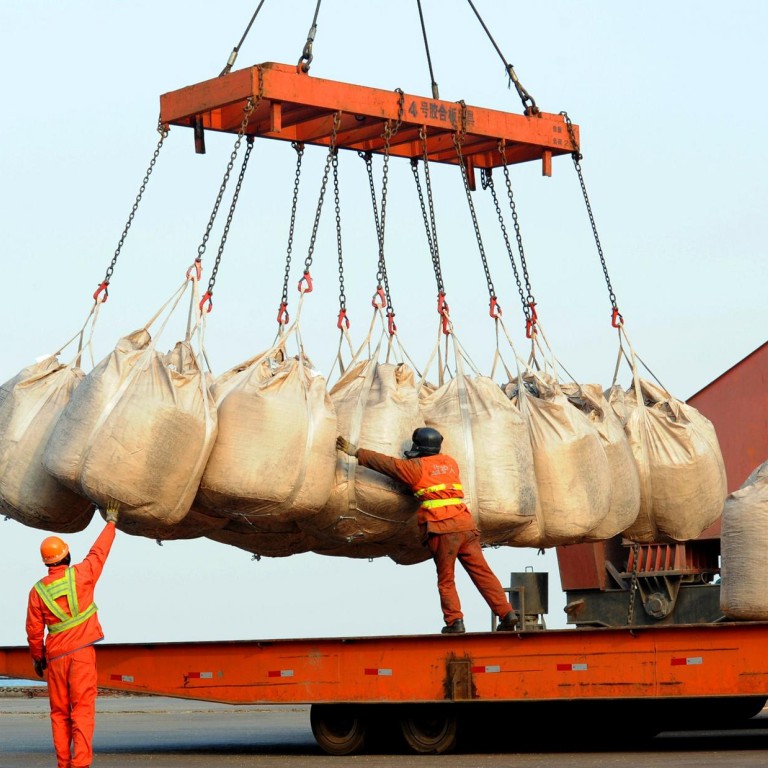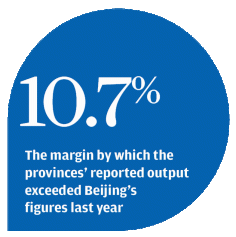
Provinces begin heeding message for realistic data
Gap in reported output between Beijing's tally and the regions' combined contribution is narrowing, reflecting a shift from focus on big numbers
The gap in reported economic output between China's provinces and national statistics narrowed for the first time in six years as Communist Party leaders vowed to reduce the focus on growth in evaluating local officials.

The data suggests regional officials are heeding directives from President Xi Jinping and his team to shift their attention toward more sustainable expansion, including reducing debt and pollution. Still, the excess of the provincial total over the national figure remains more than the size of Indonesia's economy, pointing to the room for further improvements.
"Regional authorities are showing more realistic data," said Dariusz Kowalczyk, senior economist and strategist at Credit Agricole CIB. The numbers "may reflect the change in emphasis in assessment of regional authorities away from growth towards other factors, which reduced the incentive for them to inflate the numbers."
It is the first time since 2007 that the combined provincial figures have shown a slower nominal growth rate than the central government's data. Last year's 9.2 per cent expansion compares with 9.5 per cent for the central government's figures, as reported by the National Bureau of Statistics, while the 10.6 per cent increase in provincial output in 2012 exceeded the 9.8 per cent seen in the bureau's numbers.
The last time regional growth was slower than national figures, the mainland's inflation-adjusted expansion subsequently slowed to 9.6 per cent in 2008 from 14.2 per cent in 2007.
The statistics bureau said last month that the mainland's economy grew 7.7 per cent last year on an inflation-adjusted basis, the same pace as in 2012.
The disparity between the combined provincial figures and the national number has been due partly to double counting of items and the statistics bureau was trying to correct the issue, Ma Jiantang, head of the agency, said in 2012.
One possible explanation for the narrowing disparity is that the quality of the provincial growth data improved in the eyes of the NBS, which usually adjusts the regional data to compile the figures for the mainland as a whole, said Louis Kuijs, chief China economist at Royal Bank of Scotland Group in Hong Kong.
This could have been the case if incentives for provinces to inflate or exaggerate their numbers had weakened, said Kuijs.
Mainland leaders are trying to change a system where growth was traditionally viewed as the quickest path to promotion. Local-government borrowing will used as an "important indicator" for regional officials' performance reviews and people should be punished for decisions that "result in huge losses to the country", waste resources or cause ecological damage, Xinhua reported in December.
The government targeted 7.5 per cent growth in real GDP last year and normally provides the current year's goal at the annual meeting of the National People's Congress, which begins on March 5.
About two-thirds of the provinces have already set real-GDP expansion targets for this year that are lower than 2013's goals, based on reports compiled by Bloomberg.
While almost all provinces reported real growth rates at or above the national 7.7 per cent figure, almost half indicated nominal growth below the mainland's 9.5 per cent rate. Expansion ranged as low as 4 per cent in Shanxi province, which reported a 9 per cent increase in real output.
Ding Shuang, senior China economist at Citigroup in Hong Kong, said he visited several cities last year including Changsha, the capital of Hunan province, where the economy appeared to be slowing more sharply than the mainland as a whole. Yet it's possible that the mainland figures include activity in services and internet industries that may not show up in local data, he said.
The statistics bureau has "better methodology to calculate" data on internet services, for example, said Ding. "These kinds of economic activity are becoming more and more important."
